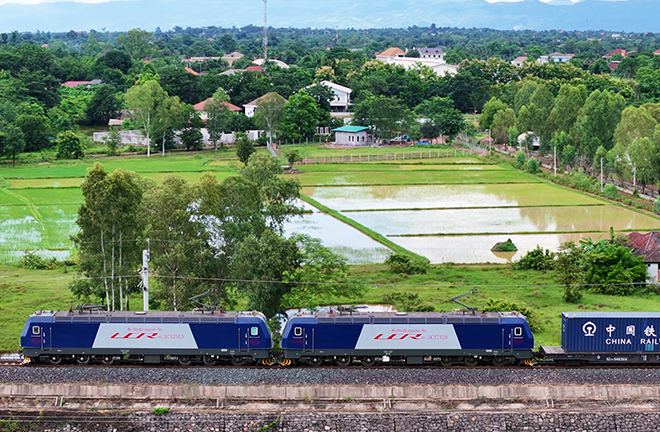China’s steady growth advances global development

A freight train of the China-Laos Railway departs from Vientiane in Laos to Kunming, Yunnan Province, China, on Aug. 5. Photo: XINHUA
Against the backdrop of sluggish economic recovery worldwide, the steady growth of the Chinese economy is particularly noteworthy. Nonetheless, certain Western countries, without a sound knowledge of China’s development, have frequently asserted that the Chinese economy is on the brink of collapse or has peaked, even accusing the country’s rapidly developing new energy sector of overcapacity.
In response to these claims, CSST recently interviewed Marcos Cordeiro Pires, a professor of international political economy at the São Paulo State University in Brazil, and Elias Jabbour, an associate professor from the School of Economics at the State University of Rio de Janeiro in Brazil and advisor to the Office of the President of the New Development Bank.
Distinctive growth model
In 2023, China’s GDP grew 5.2% year-on-year, reaching 126 trillion ($17.67 trillion) yuan. Pires attributed this achievement to the country’s model of socialist market economy with Chinese characteristics, saying that it has been very successful at combining state planning with the dynamism of companies operating in China.
“Another important aspect is how the Chinese government seeks consensus within society to move the entire population toward development,” Pires continued. “Due to this ability to understand the changes taking place, the Chinese government organizes its policies to face internal and external challenges. It does not cling to doctrines; it continues to seek the truth in facts.”
In Jabbour’s view, the Chinese economy, unlike capitalist economies, does not suffer from the evils of financialization. This means that all available resources are directed towards production, not financial speculation. The political and institutional guarantees that make the “Chinese model” unique are the political power of the Communist Party of China and a public productive and financial core comprising large state-owned business conglomerates and development-oriented banks at all levels of governance, Jabbour added.
Upgrading productive forces
To fuel economic recovery, China has identified the primary task of economic work in 2024 as driving industrial innovation through technological innovation and developing “new quality productive forces” at a faster pace.
“This is a strategy to accelerate the role of industry and high-tech production chains,” Jabbour said. These new quality productive forces, representing the forefront of innovation in areas ranging from semiconductor infrastructure to clean energy and new social equipment, demand immense backing from public assets and their financial arm, the state-owned banks that, alongside universities and non-public and private companies, collectively form an ecosystem commonly referred to as the National Technological Innovation System.
Jabbour elaborated that the great advantage of China lies in the fact that the foundation of its National Technological Innovation System is the extensive public ownership of large-scale production and finance. This system has evolved over time to meet the demands of a market-oriented socialist economy, competing with major capitalist powers.
Pires pointed out that an effective and creative economic policy must align with both present realities and long-term trends. Humanity is experiencing rapid scientific and technological progress while also confronting significant challenges, including the sustainability of life on earth, climate change, and the need to ensure people’s wellbeing. “In this aspect, one cannot look for solutions in the past to deal with future problems. New economic approaches and the creation of new citizenship related to environmentally responsible consumption are needed,” he urged.
“Because of this, it is essential to develop new quality productive forces to absorb and integrate the various emerging technologies, such as artificial intelligence, advanced robotics, biotechnology, the integration of devices through the Internet of Things, the development of new materials and energy sources, etc.,” Pires emphasized.
Global contributions
On the global level, the China-proposed Belt and Road Initiative (BRI) has created a new paradigm of international cooperation, Pires observed. The various infrastructure projects built and under construction are transforming the landscape of several countries, particularly those that struggle to secure financing and technical support for essential projects, such as hydroelectric plants, railways, clean energy generation, and ports.
Pires further explained that beyond the immediate job creation resulting from these projects, the BRI establishes a foundation for future investments. For instance, the China-Laos Railway could never have been built under the short-term, profit-driven logic typically employed by Western companies. From a short-term perspective, the cost-benefit analysis and Laos’ financial capacity to repay loans appeared insufficient. However, since the railway was opened to traffic in April 2023, it has unlocked numerous economic opportunities, particularly through integration with the Chinese consumer market, elevating the Laotian economy to a new and higher level. Similarly, developing countries on all continents receive new impetus for their development from BRI investments.
With the BRI, China is not only exporting its prosperity, Jabbour said. With the decline of globalization led by US financial capital, China is offering a new kind of globalization: productive, inclusive and able to meet the demands of all the countries receiving Chinese investment. The world now has an alternative to neoliberal destruction.
Breaking neoliberal mindset
Pires noted that no neoliberal politician or economist has the analytical capacity to understand the complexity and sophistication of economic management in socialist China. They are trapped within their ideological constraints and only see part of China’s economic performance.
Jabbour warned that the risk of presenting China from the point of view of neoliberalism is that of making the same mistakes that the vast majority of Western economists make. China is not a conventional capitalist economy, so analyzing it in the same way as countries like the United States, Germany, Japan, etc. is misguided and intellectually poor.
“China is a great paradigm for the social sciences to unravel. The world’s greatest social engineering is being built in this country. China is the future,” Jabbour concluded.
Edited by CHEN MIRONG
